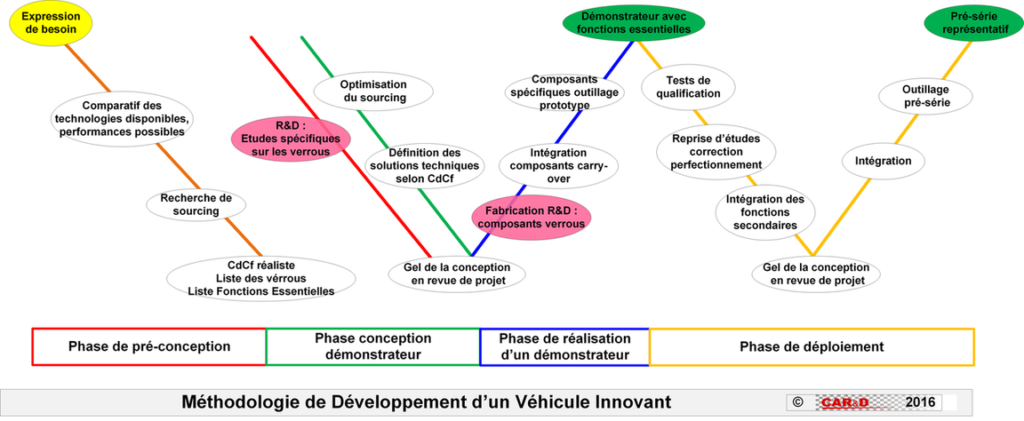Les objectifs de CAR&D
Un concentré d’excellence technique et de Créativité dans le domaine des véhicules routiers.
Une structure permanente légère « agile » et un fonctionnement en entreprise étendue avec un réseau de partenaires de haute compétence pour des prestations intégrées.
La Méthodologie
Les méthodologies de développement évoluent comme les outils et les produits :
- Dans l’industrie, le cycle en V a remplacé la méthode en cascade.
- Dans le logiciel, on tend à des méthodologies « agiles » moins formalistes et avec plus de cycles.
- Dans les bancs d’essais et les simulateurs, on tend à « hybrider » des sous-ensembles réels et des sous-ensembles virtuels.
Les tendances actuelles sont d’utiliser beaucoup :
- l’analyse fonctionnelle, l’analyse de la valeur, outils directeurs de la conception,
- le brain storming, et son équivalent visuel en design les sketches,
- la simulation et les maquettes numériques,
- les maquettes ou démonstrateurs lorsque la dimension exploratoire est forte.
Ces tendances sont illustrées en citant les maîtres :
- « Experiment is the ultimate authority », Richard Feynman, prix Nobel de physique,
- « Nichts ist praktischer, als eine gute Theorie », Theodore von Karman, directeur du Jet Propulsion Laboratory de la NASA.
Remarquons que ces deux citations sont croisées, le théoricien en appelant à l’expérimentation tandis que le spécialiste d’une science largement expérimentale en appelant à la théorie ; et si l’expérimentation et la théorie étaient les deux jambes qui permettent de marcher par leur usage alternatif ? cf la publication n°44.
Remarquant à quel point la R&D automobile est de nature incrémentale et combinatoire, on peut en déduire que trois axes sont primordiaux dans la méthodologie :
- une analyse fonctionnelle rigoureuse du projet,
- une culture technique transversale large, permettant d’effectuer des carry-over de composants ou de concepts, de trouver des solutions les plus simples possibles,
- un choix préférentiel du plus petit outil nécessaire pour obtenir une réponse, cf. Lean, Innovation Frugale, Jugaad, Innovation accelérée, Méthode Agile…

On pourra trouver ici une liste de grandes inventions techniques liées à l’automobile au sens large, souvent basées sur des briques technologiques pré-existantes et souvent remarquablement simples, qui se sont combinées peu à peu.
